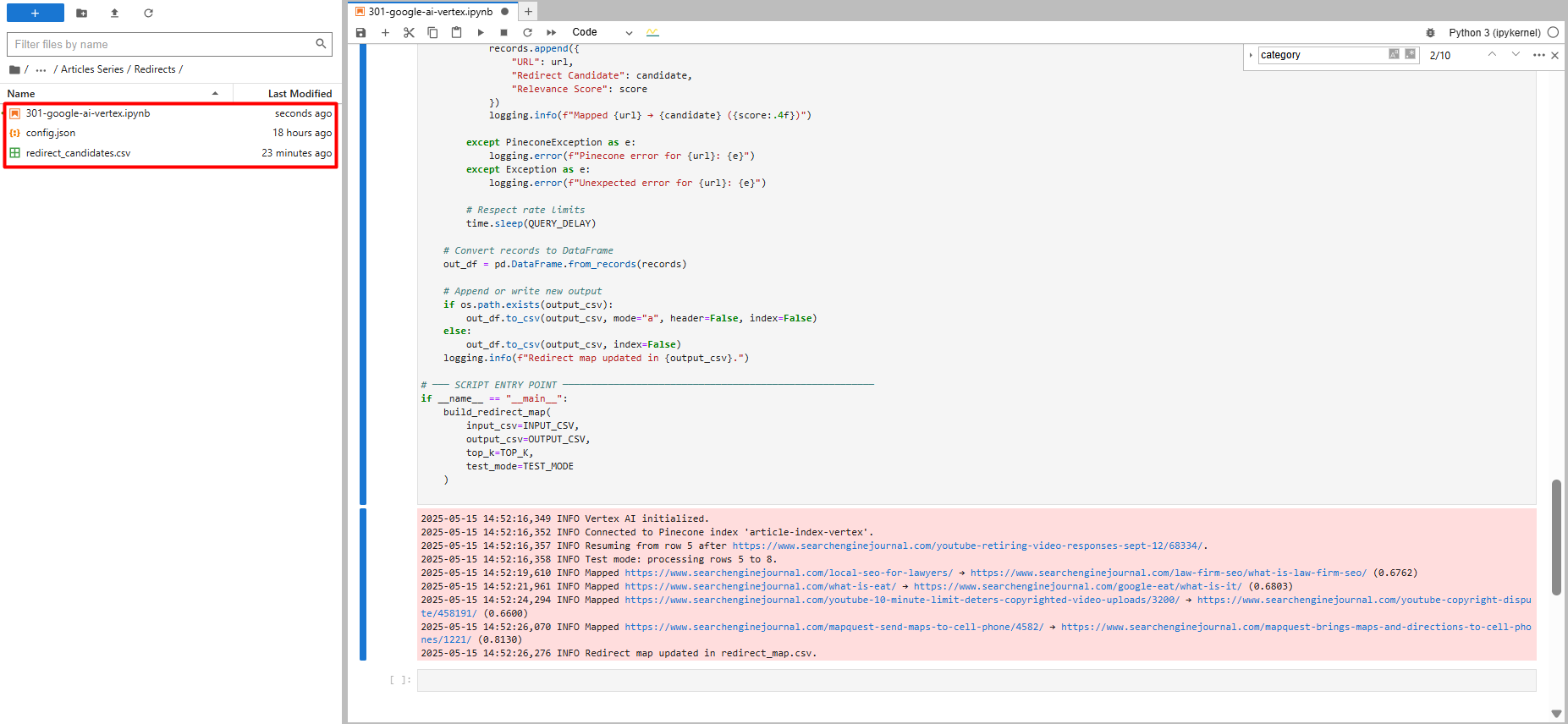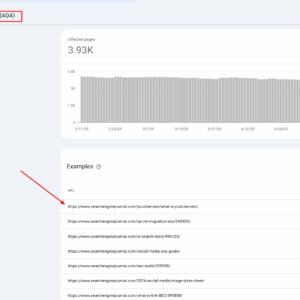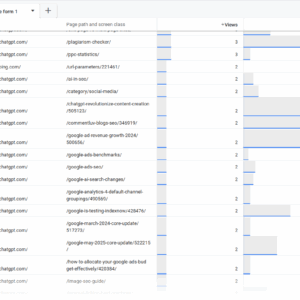
Las redirecciones son esenciales para el mantenimiento de cada sitio web, y la gestión de redireccionamientos se vuelve realmente desafiante cuando los profesionales de SEO se ocupan de sitios web que contienen millones de páginas.
Ejemplos de situaciones en las que puede necesitar implementar redireccionamientos a escala:
- Un sitio de comercio electrónico tiene una gran cantidad de productos que ya no se venden.
- Las páginas obsoletas de las publicaciones de noticias ya no son relevantes o carecen de valor histórico.
- Directorios de listado que contienen listados obsoletos.
- Juntas de trabajo donde caducan las publicaciones.
¿Por qué es esencial la redireccionamiento a escala?
Puede ayudar a mejorar la experiencia del usuario, consolidar las clasificaciones y ahorrar el presupuesto de rastreo.
Puede considerar el noindexing, pero esto no impide que Googlebot se arrastre. Prepara el presupuesto de rastreo a medida que crece el número de páginas.
Desde la perspectiva de la experiencia del usuario, aterrizar en un enlace obsoleto es frustrante. Por ejemplo, si un usuario aterriza en un listado de trabajo obsoleto, es mejor enviarlos a la coincidencia más cercana para un listado de trabajo activo.
En Search Engine Journal, obtenemos muchos 404 enlaces de AI Chatbots debido a las alucinaciones, ya que inventan URL que nunca existieron.
Utilizamos los informes de Google Analytics 4 y Google Search Console (y, a veces, registros de servidores) para extraer esas 404 páginas y redirigirlas al contenido coincidente más cercano en función de la babosa del artículo.
Cuando los chatbots nos citan a través de 404 páginas, y las personas siguen llegando a través de enlaces rotos, no es una buena experiencia de usuario.
Informe 404 URLS en GSC, mayo de 2025
404 visitas de AI Chatbots, mayo de 2025
Preparar a los candidatos de redirección
En primer lugar, lea esta publicación para aprender a crear una base de datos Vector de Pinecone. (Tenga en cuenta que en este caso, utilizamos “Primary_Category” como una clave de metadatos frente a “categoría”).
Para que esto funcione, asumimos que todos los vectores de su artículo ya están almacenados en la base de datos “Artículo-Index-Viex”.
Prepare sus URL de redirección en formato CSV como en este archivo de muestra. Esos podrían ser artículos existentes que ha decidido podar o 404 de sus informes de consola de búsqueda o GA4.
 Archivo de muestra con URL a redirigirse (Captura de pantalla de Google Sheet, mayo de 2025)
Archivo de muestra con URL a redirigirse (Captura de pantalla de Google Sheet, mayo de 2025)La información opcional de “primaria_categoría” es metadatos que existe con los registros de pinecone de sus artículos cuando los creó y se puede usar para filtrar artículos de la misma categoría, mejorando aún más la precisión.
En caso de que falte el título, por ejemplo, en 404 URL, el script extraerá palabras de Slug de la URL y las usará como entrada.
Genere redireccionamientos utilizando Google Vertex AI
Descargue sus credenciales de servicio de Google API y cambie el nombre de “config.json”, cargue el script a continuación y un archivo de muestra en el mismo directorio en Jupyter Lab, y ejecutarlo.
import os
import time
import logging
from urllib.parse import urlparse
import re
import pandas as pd
from pandas.errors import EmptyDataError
from typing import Optional, List, Dict, Any
from google.auth import load_credentials_from_file
from google.cloud import aiplatform
from google.api_core.exceptions import GoogleAPIError
from pinecone import Pinecone, PineconeException
from vertexai.language_models import TextEmbeddingModel, TextEmbeddingInput
# Import tenacity for retry mechanism. Tenacity provides a decorator to add retry logic
# to functions, making them more robust against transient errors like network issues or API rate limits.
from tenacity import retry, wait_exponential, stop_after_attempt, retry_if_exception_type
# For clearing output in Jupyter (optional, keep if running in Jupyter).
# This is useful for interactive environments to show progress without cluttering the output.
from IPython.display import clear_output
# ─── USER CONFIGURATION ───────────────────────────────────────────────────────
# Define configurable parameters for the script. These can be easily adjusted
# without modifying the core logic.
INPUT_CSV = "redirect_candidates.csv" # Path to the input CSV file containing URLs to be redirected.
# Expected columns: "URL", "Title", "primary_category".
OUTPUT_CSV = "redirect_map.csv" # Path to the output CSV file where the generated redirect map will be saved.
PINECONE_API_KEY = "YOUR_PINECONE_KEY" # Your API key for Pinecone. Replace with your actual key.
PINECONE_INDEX_NAME = "article-index-vertex" # The name of the Pinecone index where article vectors are stored.
GOOGLE_CRED_PATH = "config.json" # Path to your Google Cloud service account credentials JSON file.
EMBEDDING_MODEL_ID = "text-embedding-005" # Identifier for the Vertex AI text embedding model to use.
TASK_TYPE = "RETRIEVAL_QUERY" # The task type for the embedding model. Try with RETRIEVAL_DOCUMENT vs RETRIEVAL_QUERY to see the difference.
# This influences how the embedding vector is generated for optimal retrieval.
CANDIDATE_FETCH_COUNT = 3 # Number of potential redirect candidates to fetch from Pinecone for each input URL.
TEST_MODE = True # If True, the script will process only a small subset of the input data (MAX_TEST_ROWS).
# Useful for testing and debugging.
MAX_TEST_ROWS = 5 # Maximum number of rows to process when TEST_MODE is True.
QUERY_DELAY = 0.2 # Delay in seconds between successive API queries (to avoid hitting rate limits).
PUBLISH_YEAR_FILTER: List[int] = [] # Optional: List of years to filter Pinecone results by 'publish_year' metadata.
# If empty, no year filtering is applied.
LOG_BATCH_SIZE = 5 # Number of URLs to process before flushing the results to the output CSV.
# This helps in saving progress incrementally and managing memory.
MIN_SLUG_LENGTH = 3 # Minimum length for a URL slug segment to be considered meaningful for embedding.
# Shorter segments might be noise or less descriptive.
# Retry configuration for API calls (Vertex AI and Pinecone).
# These parameters control how the `tenacity` library retries failed API requests.
MAX_RETRIES = 5 # Maximum number of times to retry an API call before giving up.
INITIAL_RETRY_DELAY = 1 # Initial delay in seconds before the first retry.
# Subsequent retries will have exponentially increasing delays.
# ─── SETUP LOGGING ─────────────────────────────────────────────────────────────
# Configure the logging system to output informational messages to the console.
logging.basicConfig(
level=logging.INFO, # Set the logging level to INFO, meaning INFO, WARNING, ERROR, CRITICAL messages will be shown.
format="%(asctime)s %(levelname)s %(message)s" # Define the format of log messages (timestamp, level, message).
)
# ─── INITIALIZE GOOGLE VERTEX AI ───────────────────────────────────────────────
# Set the GOOGLE_APPLICATION_CREDENTIALS environment variable to point to the
# service account key file. This allows the Google Cloud client libraries to
# authenticate automatically.
os.environ["GOOGLE_APPLICATION_CREDENTIALS"] = GOOGLE_CRED_PATH
try:
# Load credentials from the specified JSON file.
credentials, project_id = load_credentials_from_file(GOOGLE_CRED_PATH)
# Initialize the Vertex AI client with the project ID and credentials.
# The location "us-central1" is specified for the AI Platform services.
aiplatform.init(project=project_id, credentials=credentials, location="us-central1")
logging.info("Vertex AI initialized.")
except Exception as e:
# Log an error if Vertex AI initialization fails and re-raise the exception
# to stop script execution, as it's a critical dependency.
logging.error(f"Failed to initialize Vertex AI: {e}")
raise
# Initialize the embedding model once globally.
# This is a crucial optimization for "Resource Management for Embedding Model".
# Loading the model takes time and resources; doing it once avoids repeated loading
# for every URL processed, significantly improving performance.
try:
GLOBAL_EMBEDDING_MODEL = TextEmbeddingModel.from_pretrained(EMBEDDING_MODEL_ID)
logging.info(f"Text Embedding Model '{EMBEDDING_MODEL_ID}' loaded.")
except Exception as e:
# Log an error if the embedding model fails to load and re-raise.
# The script cannot proceed without the embedding model.
logging.error(f"Failed to load Text Embedding Model: {e}")
raise
# ─── INITIALIZE PINECONE ──────────────────────────────────────────────────────
# Initialize the Pinecone client and connect to the specified index.
try:
pinecone = Pinecone(api_key=PINECONE_API_KEY)
index = pinecone.Index(PINECONE_INDEX_NAME)
logging.info(f"Connected to Pinecone index '{PINECONE_INDEX_NAME}'.")
except PineconeException as e:
# Log an error if Pinecone initialization fails and re-raise.
# Pinecone is a critical dependency for finding redirect candidates.
logging.error(f"Pinecone init error: {e}")
raise
# ─── HELPERS ───────────────────────────────────────────────────────────────────
def canonical_url(url: str) -> str:
"""
Converts a given URL into its canonical form by:
1. Stripping query strings (e.g., `?param=value`) and URL fragments (e.g., `#section`).
2. Handling URL-encoded fragment markers (`%23`).
3. Preserving the trailing slash if it was present in the original URL's path.
This ensures consistency with the original site's URL structure.
Args:
url (str): The input URL.
Returns:
str: The canonicalized URL.
"""
# Remove query parameters and URL fragments.
temp = url.split('?', 1)[0].split('#', 1)[0]
# Check for URL-encoded fragment markers and remove them.
enc_idx = temp.lower().find('%23')
if enc_idx != -1:
temp = temp[:enc_idx]
# Determine if the original URL path ended with a trailing slash.
has_slash = urlparse(temp).path.endswith('/')
# Remove any trailing slash temporarily for consistent processing.
temp = temp.rstrip('/')
# Re-add the trailing slash if it was originally present.
return temp + ('/' if has_slash else '')
def slug_from_url(url: str) -> str:
"""
Extracts and joins meaningful, non-numeric path segments from a canonical URL
to form a "slug" string. This slug can be used as text for embedding when
a URL's title is not available.
Args:
url (str): The input URL.
Returns:
str: A hyphen-separated string of relevant slug parts.
"""
clean = canonical_url(url) # Get the canonical version of the URL.
path = urlparse(clean).path # Extract the path component of the URL.
segments = [seg for seg in path.split('/') if seg] # Split path into segments and remove empty ones.
# Filter segments based on criteria:
# - Not purely numeric (e.g., '123' is excluded).
# - Length is greater than or equal to MIN_SLUG_LENGTH.
# - Contains at least one alphanumeric character (to exclude purely special character segments).
parts = [seg for seg in segments
if not seg.isdigit()
and len(seg) >= MIN_SLUG_LENGTH
and re.search(r'[A-Za-z0-9]', seg)]
return '-'.join(parts) # Join the filtered parts with hyphens.
# ─── EMBEDDING GENERATION FUNCTION ─────────────────────────────────────────────
# Apply retry mechanism for GoogleAPIError. This makes the embedding generation
# more resilient to transient issues like network problems or Vertex AI rate limits.
@retry(
wait=wait_exponential(multiplier=INITIAL_RETRY_DELAY, min=1, max=10), # Exponential backoff for retries.
stop=stop_after_attempt(MAX_RETRIES), # Stop retrying after a maximum number of attempts.
retry=retry_if_exception_type(GoogleAPIError), # Only retry if a GoogleAPIError occurs.
reraise=True # Re-raise the exception if all retries fail, allowing the calling function to handle it.
)
def generate_embedding(text: str) -> Optional[List[float]]:
"""
Generates a vector embedding for the given text using the globally initialized
Vertex AI Text Embedding Model. Includes retry logic for API calls.
Args:
text (str): The input text (e.g., URL title or slug) to embed.
Returns:
Optional[List[float]]: A list of floats representing the embedding vector,
or None if the input text is empty/whitespace or
if an unexpected error occurs after retries.
"""
if not text or not text.strip():
# If the text is empty or only whitespace, no embedding can be generated.
return None
try:
# Use the globally initialized model to get embeddings.
# This is the "Resource Management for Embedding Model" optimization.
inp = TextEmbeddingInput(text, task_type=TASK_TYPE)
vectors = GLOBAL_EMBEDDING_MODEL.get_embeddings([inp], output_dimensionality=768)
return vectors[0].values # Return the embedding vector (list of floats).
except GoogleAPIError as e:
# Log a warning if a GoogleAPIError occurs, then re-raise to trigger the `tenacity` retry mechanism.
logging.warning(f"Vertex AI error during embedding generation (retrying): {e}")
raise # The `reraise=True` in the decorator will catch this and retry.
except Exception as e:
# Catch any other unexpected exceptions during embedding generation.
logging.error(f"Unexpected error generating embedding: {e}")
return None # Return None for non-retryable or final failed attempts.
# ─── MAIN PROCESSING FUNCTION ─────────────────────────────────────────────────
def build_redirect_map(
input_csv: str,
output_csv: str,
fetch_count: int,
test_mode: bool
):
"""
Builds a redirect map by processing URLs from an input CSV, generating
embeddings, querying Pinecone for similar articles, and identifying
suitable redirect candidates.
Args:
input_csv (str): Path to the input CSV file.
output_csv (str): Path to the output CSV file for the redirect map.
fetch_count (int): Number of candidates to fetch from Pinecone.
test_mode (bool): If True, process only a limited number of rows.
"""
# Read the input CSV file into a Pandas DataFrame.
df = pd.read_csv(input_csv)
required = {"URL", "Title", "primary_category"}
# Validate that all required columns are present in the DataFrame.
if not required.issubset(df.columns):
raise ValueError(f"Input CSV must have columns: {required}")
# Create a set of canonicalized input URLs for efficient lookup.
# This is used to prevent an input URL from redirecting to itself or another input URL,
# which could create redirect loops or redirect to a page that is also being redirected.
input_urls = set(df["URL"].map(canonical_url))
start_idx = 0
# Implement resume functionality: if the output CSV already exists,
# try to find the last processed URL and resume from the next row.
if os.path.exists(output_csv):
try:
prev = pd.read_csv(output_csv)
except EmptyDataError:
# Handle case where the output CSV exists but is empty.
prev = pd.DataFrame()
if not prev.empty:
# Get the last URL that was processed and written to the output file.
last = prev["URL"].iloc[-1]
# Find the index of this last URL in the original input DataFrame.
idxs = df.index[df["URL"].map(canonical_url) == last].tolist()
if idxs:
# Set the starting index for processing to the row after the last processed URL.
start_idx = idxs[0] + 1
logging.info(f"Resuming from row {start_idx} after {last}.")
# Determine the range of rows to process based on test_mode.
if test_mode:
end_idx = min(start_idx + MAX_TEST_ROWS, len(df))
df_proc = df.iloc[start_idx:end_idx] # Select a slice of the DataFrame for testing.
logging.info(f"Test mode: processing rows {start_idx} to {end_idx-1}.")
else:
df_proc = df.iloc[start_idx:] # Process all remaining rows.
logging.info(f"Processing rows {start_idx} to {len(df)-1}.")
total = len(df_proc) # Total number of URLs to process in this run.
processed = 0 # Counter for successfully processed URLs.
batch: List[Dict[str, Any]] = [] # List to store results before flushing to CSV.
# Iterate over each row (URL) in the DataFrame slice to be processed.
for _, row in df_proc.iterrows():
raw_url = row["URL"] # Original URL from the input CSV.
url = canonical_url(raw_url) # Canonicalized version of the URL.
# Get title and category, handling potential missing values by defaulting to empty strings.
title = row["Title"] if isinstance(row["Title"], str) else ""
category = row["primary_category"] if isinstance(row["primary_category"], str) else ""
# Determine the text to use for generating the embedding.
# Prioritize the 'Title' if available, otherwise use a slug derived from the URL.
if title.strip():
text = title
else:
slug = slug_from_url(raw_url)
if not slug:
# If no meaningful slug can be extracted, skip this URL.
logging.info(f"Skipping {raw_url}: insufficient slug context for embedding.")
continue
text = slug.replace('-', ' ') # Prepare slug for embedding by replacing hyphens with spaces.
# Attempt to generate the embedding for the chosen text.
# This call is wrapped in a try-except block to catch final failures after retries.
try:
embedding = generate_embedding(text)
except GoogleAPIError as e:
# If embedding generation fails even after retries, log the error and skip this URL.
logging.error(f"Failed to generate embedding for {raw_url} after {MAX_RETRIES} retries: {e}")
continue # Move to the next URL.
if not embedding:
# If `generate_embedding` returned None (e.g., empty text or unexpected error), skip.
logging.info(f"Skipping {raw_url}: no embedding generated.")
continue
# Build metadata filter for Pinecone query.
# This helps narrow down search results to more relevant candidates (e.g., by category or publish year).
filt: Dict[str, Any] = {}
if category:
# Split category string by comma and strip whitespace for multiple categories.
cats = [c.strip() for c in category.split(",") if c.strip()]
if cats:
filt["primary_category"] = {"$in": cats} # Filter by categories present in Pinecone metadata.
if PUBLISH_YEAR_FILTER:
filt["publish_year"] = {"$in": PUBLISH_YEAR_FILTER} # Filter by specified publish years.
filt["id"] = {"$ne": url} # Exclude the current URL itself from the search results to prevent self-redirects.
# Define a nested function for Pinecone query with retry mechanism.
# This ensures that Pinecone queries are also robust against transient errors.
@retry(
wait=wait_exponential(multiplier=INITIAL_RETRY_DELAY, min=1, max=10),
stop=stop_after_attempt(MAX_RETRIES),
retry=retry_if_exception_type(PineconeException), # Only retry if a PineconeException occurs.
reraise=True # Re-raise the exception if all retries fail.
)
def query_pinecone_with_retry(embedding_vector, top_k_count, pinecone_filter):
"""
Performs a Pinecone index query with retry logic.
"""
return index.query(
vector=embedding_vector,
top_k=top_k_count,
include_values=False, # We don't need the actual vector values in the response.
include_metadata=False, # We don't need the metadata in the response for this logic.
filter=pinecone_filter # Apply the constructed metadata filter.
)
# Attempt to query Pinecone for redirect candidates.
try:
res = query_pinecone_with_retry(embedding, fetch_count, filt)
except PineconeException as e:
# If Pinecone query fails after retries, log the error and skip this URL.
logging.error(f"Failed to query Pinecone for {raw_url} after {MAX_RETRIES} retries: {e}")
continue # Move to the next URL.
candidate = None # Initialize redirect candidate to None.
score = None # Initialize relevance score to None.
# Iterate through the Pinecone query results (matches) to find a suitable candidate.
for m in res.get("matches", []):
cid = m.get("id") # Get the ID (URL) of the matched document in Pinecone.
# A candidate is suitable if:
# 1. It exists (cid is not None).
# 2. It's not the original URL itself (to prevent self-redirects).
# 3. It's not another URL from the input_urls set (to prevent redirecting to a page that's also being redirected).
if cid and cid != url and cid not in input_urls:
candidate = cid # Assign the first valid candidate found.
score = m.get("score") # Get the relevance score of this candidate.
break # Stop after finding the first suitable candidate (Pinecone returns by relevance).
# Append the results for the current URL to the batch.
batch.append({"URL": url, "Redirect Candidate": candidate, "Relevance Score": score})
processed += 1 # Increment the counter for processed URLs.
msg = f"Mapped {url} → {candidate}"
if score is not None:
msg += f" ({score:.4f})" # Add score to log message if available.
logging.info(msg) # Log the mapping result.
# Periodically flush the batch results to the output CSV.
if processed % LOG_BATCH_SIZE == 0:
out_df = pd.DataFrame(batch) # Convert the current batch to a DataFrame.
# Determine file mode: 'a' (append) if file exists, 'w' (write) if new.
mode="a" if os.path.exists(output_csv) else 'w'
# Determine if header should be written (only for new files).
header = not os.path.exists(output_csv)
# Write the batch to the CSV.
out_df.to_csv(output_csv, mode=mode, header=header, index=False)
batch.clear() # Clear the batch after writing to free memory.
if not test_mode:
# clear_output(wait=True) # Uncomment if running in Jupyter and want to clear output
clear_output(wait=True)
print(f"Progress: {processed} / {total}") # Print progress update.
time.sleep(QUERY_DELAY) # Pause for a short delay to avoid overwhelming APIs.
# After the loop, write any remaining items in the batch to the output CSV.
if batch:
out_df = pd.DataFrame(batch)
mode="a" if os.path.exists(output_csv) else 'w'
header = not os.path.exists(output_csv)
out_df.to_csv(output_csv, mode=mode, header=header, index=False)
logging.info(f"Completed. Total processed: {processed}") # Log completion message.
if __name__ == "__main__":
# This block ensures that build_redirect_map is called only when the script is executed directly.
# It passes the user-defined configuration parameters to the main function.
build_redirect_map(INPUT_CSV, OUTPUT_CSV, CANDIDATE_FETCH_COUNT, TEST_MODE)
Verá una prueba ejecutada con solo cinco registros, y verá un nuevo archivo llamado “redirect_map.csv”, que contiene sugerencias de redirección.
Una vez que se asegure de que el código se ejecute sin problemas, puede establecer el TEST_MODE booleano a la verdad False y ejecute el script para todas sus URL.
 Prueba de ejecución con solo cinco registros (imagen del autor, mayo de 2025)
Prueba de ejecución con solo cinco registros (imagen del autor, mayo de 2025)Si el código se detiene y se reanuda, aumenta dónde lo dejó. También verifica cada redirección que encuentra con el archivo CSV.
Esta verificación evita seleccionar una URL de la base de datos en la lista podada. Seleccionar dicha URL podría causar un bucle de redirección infinito.
Para nuestras URL de muestra, la salida se muestra a continuación.
 Redirige candidatos utilizando el tipo de tarea de Google Vertex AI Recuperación_query (imagen del autor, mayo de 2025)
Redirige candidatos utilizando el tipo de tarea de Google Vertex AI Recuperación_query (imagen del autor, mayo de 2025)Ahora podemos tomar este mapa de redirección e importarlo a nuestro administrador de redireccionamiento en el sistema de gestión de contenido (CMS), ¡y eso es todo!
Puede ver cómo logró que coincida con el artículo anticuado del artículo de noticias de 2013 “Respuestas de video retiradas de YouTube el 12 de septiembre” con el nuevo y altamente relevante artículo de noticias de 2022 “YouTube adopta la función de Tiktok – Responda a los comentarios con un video”.
También para “/What-is-eat/”, encontró una coincidencia con “/Google-eat/What-is-it/”, que es una coincidencia 100% perfecta.
Esto no se debe solo al poder de la calidad de Google Vertex LLM, sino también al resultado de elegir los parámetros correctos.
Cuando uso “recuperación_document” como el tipo de tarea al generar incrustaciones de vectores de consulta para el artículo de YouTube News que se muestra anteriormente, coincide con “YouTube expande las publicaciones de la comunidad a más creadores”, que todavía es relevante pero no tan bueno como el otro.
Para “/what-is-eat/”, coincide con el artículo “/reinventa-eeat-to-drive-sana-sales-y-search-visibilidad/545790/, que no es tan bueno como”/google-eat/what-is-it/”.
Si desea encontrar coincidencias de redirección de su grupo de artículos frescos, puede consultar Pinecone con un filtro de metadatos adicional, “Publish_year”, si tiene ese campo de metadatos en sus registros de Pinecone, que recomiendo crear.
En el código, es un PUBLISH_YEAR_FILTER variable.
Si tienes publish_year metadatos, puede establecer los años como valores de matriz, y extraerá artículos publicados en los años especificados.
Genere redireccionamientos utilizando los incrustaciones de texto de Openai
Hagamos la misma tarea con el modelo “Texto-Embeding-ADA-002” de OpenAI. El propósito es mostrar la diferencia en la producción de Google Vertex AI.
Simplemente cree un nuevo archivo de cuaderno en el mismo directorio, copie y pegue este código, y ejecútelo.
import os
import time
import logging
from urllib.parse import urlparse
import re
import pandas as pd
from pandas.errors import EmptyDataError
from typing import Optional, List, Dict, Any
from openai import OpenAI
from pinecone import Pinecone, PineconeException
# Import tenacity for retry mechanism. Tenacity provides a decorator to add retry logic
# to functions, making them more robust against transient errors like network issues or API rate limits.
from tenacity import retry, wait_exponential, stop_after_attempt, retry_if_exception_type
# For clearing output in Jupyter (optional, keep if running in Jupyter)
from IPython.display import clear_output
# ─── USER CONFIGURATION ───────────────────────────────────────────────────────
# Define configurable parameters for the script. These can be easily adjusted
# without modifying the core logic.
INPUT_CSV = "redirect_candidates.csv" # Path to the input CSV file containing URLs to be redirected.
# Expected columns: "URL", "Title", "primary_category".
OUTPUT_CSV = "redirect_map.csv" # Path to the output CSV file where the generated redirect map will be saved.
PINECONE_API_KEY = "YOUR_PINECONE_API_KEY" # Your API key for Pinecone. Replace with your actual key.
PINECONE_INDEX_NAME = "article-index-ada" # The name of the Pinecone index where article vectors are stored.
OPENAI_API_KEY = "YOUR_OPENAI_API_KEY" # Your API key for OpenAI. Replace with your actual key.
OPENAI_EMBEDDING_MODEL_ID = "text-embedding-ada-002" # Identifier for the OpenAI text embedding model to use.
CANDIDATE_FETCH_COUNT = 3 # Number of potential redirect candidates to fetch from Pinecone for each input URL.
TEST_MODE = True # If True, the script will process only a small subset of the input data (MAX_TEST_ROWS).
# Useful for testing and debugging.
MAX_TEST_ROWS = 5 # Maximum number of rows to process when TEST_MODE is True.
QUERY_DELAY = 0.2 # Delay in seconds between successive API queries (to avoid hitting rate limits).
PUBLISH_YEAR_FILTER: List[int] = [] # Optional: List of years to filter Pinecone results by 'publish_year' metadata eg. [2024,2025].
# If empty, no year filtering is applied.
LOG_BATCH_SIZE = 5 # Number of URLs to process before flushing the results to the output CSV.
# This helps in saving progress incrementally and managing memory.
MIN_SLUG_LENGTH = 3 # Minimum length for a URL slug segment to be considered meaningful for embedding.
# Shorter segments might be noise or less descriptive.
# Retry configuration for API calls (OpenAI and Pinecone).
# These parameters control how the `tenacity` library retries failed API requests.
MAX_RETRIES = 5 # Maximum number of times to retry an API call before giving up.
INITIAL_RETRY_DELAY = 1 # Initial delay in seconds before the first retry.
# Subsequent retries will have exponentially increasing delays.
# ─── SETUP LOGGING ─────────────────────────────────────────────────────────────
# Configure the logging system to output informational messages to the console.
logging.basicConfig(
level=logging.INFO, # Set the logging level to INFO, meaning INFO, WARNING, ERROR, CRITICAL messages will be shown.
format="%(asctime)s %(levelname)s %(message)s" # Define the format of log messages (timestamp, level, message).
)
# ─── INITIALIZE OPENAI CLIENT & PINECONE ───────────────────────────────────────
# Initialize the OpenAI client once globally. This handles resource management efficiently
# as the client object manages connections and authentication.
client = OpenAI(api_key=OPENAI_API_KEY)
try:
# Initialize the Pinecone client and connect to the specified index.
pinecone = Pinecone(api_key=PINECONE_API_KEY)
index = pinecone.Index(PINECONE_INDEX_NAME)
logging.info(f"Connected to Pinecone index '{PINECONE_INDEX_NAME}'.")
except PineconeException as e:
# Log an error if Pinecone initialization fails and re-raise.
# Pinecone is a critical dependency for finding redirect candidates.
logging.error(f"Pinecone init error: {e}")
raise
# ─── HELPERS ───────────────────────────────────────────────────────────────────
def canonical_url(url: str) -> str:
"""
Converts a given URL into its canonical form by:
1. Stripping query strings (e.g., `?param=value`) and URL fragments (e.g., `#section`).
2. Handling URL-encoded fragment markers (`%23`).
3. Preserving the trailing slash if it was present in the original URL's path.
This ensures consistency with the original site's URL structure.
Args:
url (str): The input URL.
Returns:
str: The canonicalized URL.
"""
# Remove query parameters and URL fragments.
temp = url.split('?', 1)[0]
temp = temp.split('#', 1)[0]
# Check for URL-encoded fragment markers and remove them.
enc_idx = temp.lower().find('%23')
if enc_idx != -1:
temp = temp[:enc_idx]
# Determine if the original URL path ended with a trailing slash.
preserve_slash = temp.endswith('/')
# Strip trailing slash if not originally present.
if not preserve_slash:
temp = temp.rstrip('/')
return temp
def slug_from_url(url: str) -> str:
"""
Extracts and joins meaningful, non-numeric path segments from a canonical URL
to form a "slug" string. This slug can be used as text for embedding when
a URL's title is not available.
Args:
url (str): The input URL.
Returns:
str: A hyphen-separated string of relevant slug parts.
"""
clean = canonical_url(url) # Get the canonical version of the URL.
path = urlparse(clean).path # Extract the path component of the URL.
segments = [seg for seg in path.split('/') if seg] # Split path into segments and remove empty ones.
# Filter segments based on criteria:
# - Not purely numeric (e.g., '123' is excluded).
# - Length is greater than or equal to MIN_SLUG_LENGTH.
# - Contains at least one alphanumeric character (to exclude purely special character segments).
parts = [seg for seg in segments
if not seg.isdigit()
and len(seg) >= MIN_SLUG_LENGTH
and re.search(r'[A-Za-z0-9]', seg)]
return '-'.join(parts) # Join the filtered parts with hyphens.
# ─── EMBEDDING GENERATION FUNCTION ─────────────────────────────────────────────
# Apply retry mechanism for OpenAI API errors. This makes the embedding generation
# more resilient to transient issues like network problems or API rate limits.
@retry(
wait=wait_exponential(multiplier=INITIAL_RETRY_DELAY, min=1, max=10), # Exponential backoff for retries.
stop=stop_after_attempt(MAX_RETRIES), # Stop retrying after a maximum number of attempts.
retry=retry_if_exception_type(Exception), # Retry on any Exception from OpenAI client (can be refined to openai.APIError if desired).
reraise=True # Re-raise the exception if all retries fail, allowing the calling function to handle it.
)
def generate_embedding(text: str) -> Optional[List[float]]:
"""
Generate a vector embedding for the given text using OpenAI's text-embedding-ada-002
via the globally initialized OpenAI client. Includes retry logic for API calls.
Args:
text (str): The input text (e.g., URL title or slug) to embed.
Returns:
Optional[List[float]]: A list of floats representing the embedding vector,
or None if the input text is empty/whitespace or
if an unexpected error occurs after retries.
"""
if not text or not text.strip():
# If the text is empty or only whitespace, no embedding can be generated.
return None
try:
resp = client.embeddings.create( # Use the globally initialized OpenAI client to get embeddings.
model=OPENAI_EMBEDDING_MODEL_ID,
input=text
)
return resp.data[0].embedding # Return the embedding vector (list of floats).
except Exception as e:
# Log a warning if an OpenAI error occurs, then re-raise to trigger the `tenacity` retry mechanism.
logging.warning(f"OpenAI embedding error (retrying): {e}")
raise # The `reraise=True` in the decorator will catch this and retry.
# ─── MAIN PROCESSING FUNCTION ─────────────────────────────────────────────────
def build_redirect_map(
input_csv: str,
output_csv: str,
fetch_count: int,
test_mode: bool
):
"""
Builds a redirect map by processing URLs from an input CSV, generating
embeddings, querying Pinecone for similar articles, and identifying
suitable redirect candidates.
Args:
input_csv (str): Path to the input CSV file.
output_csv (str): Path to the output CSV file for the redirect map.
fetch_count (int): Number of candidates to fetch from Pinecone.
test_mode (bool): If True, process only a limited number of rows.
"""
# Read the input CSV file into a Pandas DataFrame.
df = pd.read_csv(input_csv)
required = {"URL", "Title", "primary_category"}
# Validate that all required columns are present in the DataFrame.
if not required.issubset(df.columns):
raise ValueError(f"Input CSV must have columns: {required}")
# Create a set of canonicalized input URLs for efficient lookup.
# This is used to prevent an input URL from redirecting to itself or another input URL,
# which could create redirect loops or redirect to a page that is also being redirected.
input_urls = set(df["URL"].map(canonical_url))
start_idx = 0
# Implement resume functionality: if the output CSV already exists,
# try to find the last processed URL and resume from the next row.
if os.path.exists(output_csv):
try:
prev = pd.read_csv(output_csv)
except EmptyDataError:
# Handle case where the output CSV exists but is empty.
prev = pd.DataFrame()
if not prev.empty:
# Get the last URL that was processed and written to the output file.
last = prev["URL"].iloc[-1]
# Find the index of this last URL in the original input DataFrame.
idxs = df.index[df["URL"].map(canonical_url) == last].tolist()
if idxs:
# Set the starting index for processing to the row after the last processed URL.
start_idx = idxs[0] + 1
logging.info(f"Resuming from row {start_idx} after {last}.")
# Determine the range of rows to process based on test_mode.
if test_mode:
end_idx = min(start_idx + MAX_TEST_ROWS, len(df))
df_proc = df.iloc[start_idx:end_idx] # Select a slice of the DataFrame for testing.
logging.info(f"Test mode: processing rows {start_idx} to {end_idx-1}.")
else:
df_proc = df.iloc[start_idx:] # Process all remaining rows.
logging.info(f"Processing rows {start_idx} to {len(df)-1}.")
total = len(df_proc) # Total number of URLs to process in this run.
processed = 0 # Counter for successfully processed URLs.
batch: List[Dict[str, Any]] = [] # List to store results before flushing to CSV.
# Iterate over each row (URL) in the DataFrame slice to be processed.
for _, row in df_proc.iterrows():
raw_url = row["URL"] # Original URL from the input CSV.
url = canonical_url(raw_url) # Canonicalized version of the URL.
# Get title and category, handling potential missing values by defaulting to empty strings.
title = row["Title"] if isinstance(row["Title"], str) else ""
category = row["primary_category"] if isinstance(row["primary_category"], str) else ""
# Determine the text to use for generating the embedding.
# Prioritize the 'Title' if available, otherwise use a slug derived from the URL.
if title.strip():
text = title
else:
raw_slug = slug_from_url(raw_url)
if not raw_slug or len(raw_slug) < MIN_SLUG_LENGTH:
# If no meaningful slug can be extracted, skip this URL.
logging.info(f"Skipping {raw_url}: insufficient slug context.")
continue
text = raw_slug.replace('-', ' ').replace('_', ' ') # Prepare slug for embedding by replacing hyphens with spaces.
# Attempt to generate the embedding for the chosen text.
# This call is wrapped in a try-except block to catch final failures after retries.
try:
embedding = generate_embedding(text)
except Exception as e: # Catch any exception from generate_embedding after all retries.
# If embedding generation fails even after retries, log the error and skip this URL.
logging.error(f"Failed to generate embedding for {raw_url} after {MAX_RETRIES} retries: {e}")
continue # Move to the next URL.
if not embedding:
# If `generate_embedding` returned None (e.g., empty text or unexpected error), skip.
logging.info(f"Skipping {raw_url}: no embedding.")
continue
# Build metadata filter for Pinecone query.
# This helps narrow down search results to more relevant candidates (e.g., by category or publish year).
filt: Dict[str, Any] = {}
if category:
# Split category string by comma and strip whitespace for multiple categories.
cats = [c.strip() for c in category.split(",") if c.strip()]
if cats:
filt["primary_category"] = {"$in": cats} # Filter by categories present in Pinecone metadata.
if PUBLISH_YEAR_FILTER:
filt["publish_year"] = {"$in": PUBLISH_YEAR_FILTER} # Filter by specified publish years.
filt["id"] = {"$ne": url} # Exclude the current URL itself from the search results to prevent self-redirects.
# Define a nested function for Pinecone query with retry mechanism.
# This ensures that Pinecone queries are also robust against transient errors.
@retry(
wait=wait_exponential(multiplier=INITIAL_RETRY_DELAY, min=1, max=10),
stop=stop_after_attempt(MAX_RETRIES),
retry=retry_if_exception_type(PineconeException), # Only retry if a PineconeException occurs.
reraise=True # Re-raise the exception if all retries fail.
)
def query_pinecone_with_retry(embedding_vector, top_k_count, pinecone_filter):
"""
Performs a Pinecone index query with retry logic.
"""
return index.query(
vector=embedding_vector,
top_k=top_k_count,
include_values=False, # We don't need the actual vector values in the response.
include_metadata=False, # We don't need the metadata in the response for this logic.
filter=pinecone_filter # Apply the constructed metadata filter.
)
# Attempt to query Pinecone for redirect candidates.
try:
res = query_pinecone_with_retry(embedding, fetch_count, filt)
except PineconeException as e:
# If Pinecone query fails after retries, log the error and skip this URL.
logging.error(f"Failed to query Pinecone for {raw_url} after {MAX_RETRIES} retries: {e}")
continue
candidate = None # Initialize redirect candidate to None.
score = None # Initialize relevance score to None.
# Iterate through the Pinecone query results (matches) to find a suitable candidate.
for m in res.get("matches", []):
cid = m.get("id") # Get the ID (URL) of the matched document in Pinecone.
# A candidate is suitable if:
# 1. It exists (cid is not None).
# 2. It's not the original URL itself (to prevent self-redirects).
# 3. It's not another URL from the input_urls set (to prevent redirecting to a page that's also being redirected).
if cid and cid != url and cid not in input_urls:
candidate = cid # Assign the first valid candidate found.
score = m.get("score") # Get the relevance score of this candidate.
break # Stop after finding the first suitable candidate (Pinecone returns by relevance).
# Append the results for the current URL to the batch.
batch.append({"URL": url, "Redirect Candidate": candidate, "Relevance Score": score})
processed += 1 # Increment the counter for processed URLs.
msg = f"Mapped {url} → {candidate}"
if score is not None:
msg += f" ({score:.4f})" # Add score to log message if available.
logging.info(msg) # Log the mapping result.
# Periodically flush the batch results to the output CSV.
if processed % LOG_BATCH_SIZE == 0:
out_df = pd.DataFrame(batch) # Convert the current batch to a DataFrame.
# Determine file mode: 'a' (append) if file exists, 'w' (write) if new.
mode="a" if os.path.exists(output_csv) else 'w'
# Determine if header should be written (only for new files).
header = not os.path.exists(output_csv)
# Write the batch to the CSV.
out_df.to_csv(output_csv, mode=mode, header=header, index=False)
batch.clear() # Clear the batch after writing to free memory.
if not test_mode:
clear_output(wait=True) # Clear output in Jupyter for cleaner progress display.
print(f"Progress: {processed} / {total}") # Print progress update.
time.sleep(QUERY_DELAY) # Pause for a short delay to avoid overwhelming APIs.
# After the loop, write any remaining items in the batch to the output CSV.
if batch:
out_df = pd.DataFrame(batch)
mode="a" if os.path.exists(output_csv) else 'w'
header = not os.path.exists(output_csv)
out_df.to_csv(output_csv, mode=mode, header=header, index=False)
logging.info(f"Completed. Total processed: {processed}") # Log completion message.
if __name__ == "__main__":
# This block ensures that build_redirect_map is called only when the script is executed directly.
# It passes the user-defined configuration parameters to the main function.
build_redirect_map(INPUT_CSV, OUTPUT_CSV, CANDIDATE_FETCH_COUNT, TEST_MODE)
Si bien la calidad de la salida puede considerarse satisfactoria, no alcanza la calidad observada con Google Vertex Ai.
A continuación en la tabla, puede ver la diferencia en la calidad de la salida.
| Url | Vértice de Google | Abierta ai |
| /What-is-eat/ | /google-eat/what-is-it/ | /5-things-you-do-do-right ahora |
| /Local-Seo-For-Lawyers/ | /Law-Firm-Seo/What-is-Law-Firm-Seo/ | /Legal-Seo-Conference-Exclusivamente para la ley-Spa/528149/ |
Cuando se trata de SEO, a pesar de que Google Vertex Ai es tres veces más caro que el modelo de OpenAI, prefiero usar Vertex.
La calidad de los resultados es significativamente mayor. Si bien puede incurrir en un costo mayor por unidad de texto procesado, se beneficia de la calidad de salida superior, lo que ahorra directamente un tiempo valioso para revisar y validar los resultados.
Desde mi experiencia, cuesta alrededor de $ 0.04 procesar 20,000 URL utilizando Google Vertex Ai.
Si bien se dice que es más costoso, todavía es ridículamente barato, y no debe preocuparse si está lidiando con tareas que involucran unos pocos miles de URL.
En el caso de procesar 1 millón de URL, el precio proyectado sería de aproximadamente $ 2.
Si aún desea un método gratuito, use los modelos Bert y Llama de abrazar la cara para generar embedidas vectoriales sin pagar una tarifa por llamado.
El costo real proviene de la potencia de cómputo necesaria para ejecutar los modelos, y debe generar integridades vectoriales de todos sus artículos en Pinecone o cualquier otra base de datos de vectores utilizando esos modelos si consultas utilizando vectores generados por Bert o LLAMA.
En resumen: AI es tu poderoso aliado
AI le permite escalar su SEO o esfuerzos de marketing y automatizar las tareas más tediosas.
Esto no reemplaza su experiencia. Está diseñado para nivelar sus habilidades y equiparlo para enfrentar desafíos con una mayor capacidad, lo que hace que el proceso sea más atractivo y divertido.
Dominar estas herramientas es esencial para el éxito. Me apasiona escribir sobre este tema para ayudar a los principiantes a aprender y sentirse inspirado.
A medida que avanzamos en esta serie, exploraremos cómo usar Google Vertex AI para construir un complemento interno de vinculación de WordPress.
Más recursos:
Imagen destacada: BestforBest/Shutterstock







